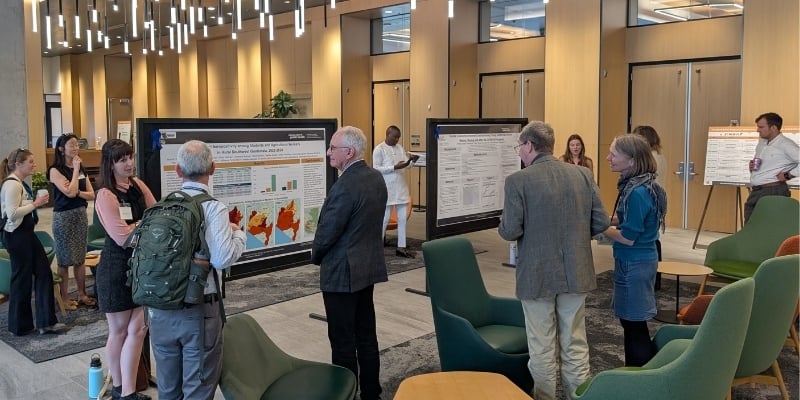Across Colorado, thousands of students filing into classrooms this school year are sharing their space with new companions. These nearly silent classmates don’t occupy desks or pore over textbooks. But they are as focused on gathering information and contributing to a positive class environment as the most dedicated student.
The new arrivals are thousands of classroom air quality monitors and portable air cleaners installed as part of a Centers for Disease Control and Prevention-funded study through the Colorado Department of Health and Environment and the University of Colorado Boulder.
A follow-up study, also funded by the CDC through the Colorado School of Public Health at the CU Anschutz Medical Campus and CU Boulder, aims to evaluate the impact of the portable air cleaner operations on the classroom environment.
With new CDC support of $2.2M, a multidisciplinary team will answer questions that are vital to environmental health: is the quality of indoor air in classrooms associated with student absenteeism and/or with the presence of viruses responsible for respiratory diseases, including SARS-CoV-2, influenza, and respiratory syncytial virus (RSV)?
Engineering and epidemiology aim to clear the air
The joint initiative brings together epidemiology and engineering in an effort to protect children’s health. Thomas Jaenisch, MD, PhD, principal investigator and associate professor in the ColoradoSPH Department of Epidemiology and the Center for Global Health, will lead efforts to measure absenteeism rates and test for the three viruses with desk- and nose-swabbing. Mark Hernandez, PE, PhD, the SJ Archuleta Professor in the Environmental Engineering program at the University of Colorado Boulder, will lead the classroom indoor air quality assessments, among other tasks.
“My job is to measure what you breathe into your nose and mouth, [epidemiology’s] job is to measure what happens after it gets there,” Hernandez said. The team of experts also includes May Chu, PhD, clinical professor of epidemiology and interim director for the Center for Global Health; Daniel Olson, MD, PhD, assistant professor of epidemiology and pediatric infectious disease at Children’s Hospital Colorado; and Bailey Fosdick, PhD, associate professor of biostatistics and informatics for ColoradoSPH.
Discovering what is in the air
The new research work began this year with the installation of indoor air quality monitors in K-12 classrooms across Colorado. All schools were eligible for the monitors, which collects data on the levels of airborne particulate matter suspended in both indoor and outdoor air, carbon dioxide, and volatile organic chemicals, as well as temperature and humidity. The monitors display the real-time air quality data for each classroom on an easy-to-read dashboard.
The second piece of the data-gathering puzzle are some 30,000 portable air cleaners provided to schools that agreed to accept them (the choice of whether or not to do so was completely in the hands of school district leaders, Hernandez emphasized). The statewide installation of monitors and air cleaners was based on the findings of a 2021 pilot study of 20 Denver Public School (DPS) elementary schools, led by Hernandez. That initiative produced air quality data for classrooms both with and without the air purifiers. Researchers made head-to-head comparisons of the data based on classroom size, number of students, architectural layout, the age of the school building, the ventilation system and other infrastructure factors, Hernandez said.
The pilot study documented a reduction in respirable airborne particulates when portable air cleaners were used in the classroom.
“In most cases [the differences] were significant; in others they were overwhelming,” Hernandez said. The new study can now use the same approach to make classroom air quality comparisons between classrooms with and without portable air cleaners, but on a much broader scale.
Building the study’s statistical power
Jaenisch noted the importance of installing the monitors in schools serving large numbers of low-income students in industrial areas, near highways, or in neighborhoods with higher levels of outdoor air pollution. Those factors may affect the air students breathe in the classroom, he said.
“Indoor air quality data is the main point, but we are also considering outside air quality as a confounder or co-factor,” Jaenisch said. At the same time, the monitors will also collect data from schools in areas with cleaner outdoor air, he added. The idea is to build a deep reservoir of data, a key to strengthening the researchers’ analysis.
“We need data from both extremes to fully understand the effects of the interventions,” Jaenisch said.
Airing out the effects of absenteeism
With precise air quality measurements over several seasons, the researchers will explore their possible connection to “health endpoints in students,” Jaenisch said. The first question: is improved classroom air quality associated with lower absenteeism rates? It’s a key question for schools across Colorado: the Colorado Department of Education reported that nearly one-third of students statewide were “chronically absent” in 2021-22, greatly increasing their risk of dropping out.
The risks of children staying home from school could ripple far beyond the classroom, Jaenisch said.
“If the children are not in school, what does it mean for the families?” he asked. “If they stay at home, usually one of the parents needs to stay with them – or they stay with grandparents and risk infecting them. That was really an important part of the pandemic’s hardship. The children could not go to school. As a society we have to make sure that we have the best interventions possible, so children can go to school safely.”
Jaenisch acknowledged that at least for now, it’s difficult to pin down the precise reasons for a student’s absence. But he noted the research team is working with DPS to develop a “more granular algorithm” for reporting the reason for absences. There are many details to be ironed out, but a new system could launch for the 2024-25 school year, Jaenisch said.
Rooting out the rogue viruses
The second research question is whether using portable air cleaners can be associated with reducing levels of the three key respiratory viruses, which can, of course, contribute to illness and absenteeism. Jaenisch said in a “subset” of DPS classrooms the team will conduct desktop- and nose-swabbing to detect the pathogens. The samples will be processed and analyzed at Hernandez’s Aerobiology lab at CU Boulder.
Jaenisch added that for validation, researchers will be able to consider data from the Colorado Department of Health and Environment and Children’s Hospital Colorado about numbers of respiratory illnesses among youngsters during the upcoming peak viral season. That data could then be linked back to the number of school absences and overlaid with information about the classroom air quality during the same time.
“Looking at that will help us to tease out if there is really an imprint of the respiratory viruses on absenteeism in that time period,” Jaenisch said.
A unique approach to monitoring health
Hernandez said the joint study could be a national model for school districts and local governments making decisions about adapting classrooms to make them safer and healthier places for children. He noted that the trial is the first in the country to wed data from air quality monitoring and portable air cleaners to assessments of their possible effects on absenteeism.
However, school districts must commit to looking squarely at what the data tells them about the quality of the air circulating in their classrooms, Hernandez said.
“You can’t manage what you don’t measure,” he said. “If you don’t measure air quality, you can’t manage it. Don’t be afraid of it; be informed by it.”
The desire to find ways to keep children safe drives Hernandez’s involvement with and commitment to the study.
“These are children. They are in school. They have no choice about the air they breathe,” he said. “It’s my job as a civil engineer to protect the public health the best I can.”
CU Anschutz
Fitzsimons Building
13001 East 17th Place
3rd Floor
Mail Stop B119
Aurora, CO 80045






